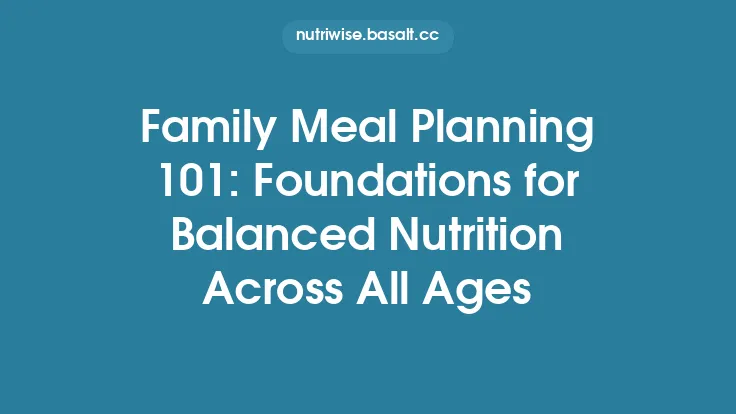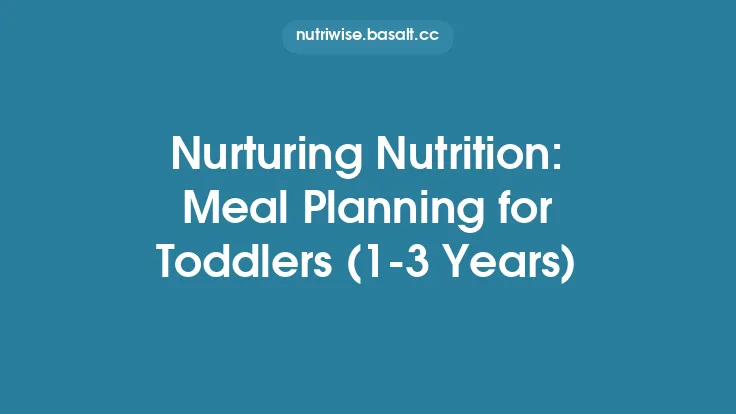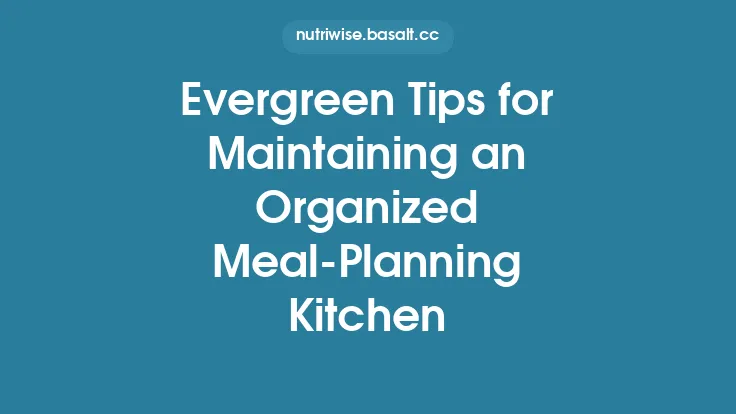When the clock is constantly ticking and the family calendar is packed from sunrise to sunset, the idea of serving wholesome, home‑cooked meals can feel like a distant dream. Yet, with a few strategic tweaks to how you organize, shop, and prep, you can keep the dinner table stocked with nutritious food without sacrificing precious time. Below is a step‑by‑step guide that shows how to turn a chaotic schedule into a streamlined meal‑preparation system that works for every member of the household.
Why Streamlined Meal Planning Matters
A well‑structured plan does more than just reduce the nightly scramble for dinner; it creates a ripple effect that touches every aspect of family life:
- Predictable routines – Knowing what’s on the table each night reduces decision fatigue for both parents and kids.
- Reduced stress – Fewer last‑minute trips to the store and fewer “what’s for dinner?” arguments.
- Cost control – Bulk buying and reduced food waste translate directly into savings.
- Consistent nutrition – Even when time is short, a plan ensures that meals still meet the family’s health standards.
Mapping Your Family’s Weekly Rhythm
- Audit the calendar – Pull out a weekly view of work shifts, school activities, extracurriculars, and any regular appointments. Highlight the evenings that are truly “open” versus those that are “tight.”
- Identify anchor points – Pinpoint at least two nights where you have a solid 60‑minute window for cooking. These become your “cook‑heavy” nights.
- Slot quick‑fire meals – For the remaining evenings, earmark 15‑30‑minute recipes that can be assembled or reheated with minimal effort.
- Create a visual board – Use a whiteboard, magnetic calendar, or a shared digital board (e.g., Google Calendar) to display the weekly plan. Seeing the whole picture helps everyone stay on the same page.
Choosing Recipes That Fit Tight Windows
When selecting dishes for a busy schedule, keep the following criteria in mind:
| Criterion | What to Look For | Why It Helps |
|---|---|---|
| Prep‑to‑Cook Ratio | ≤ 1:2 (e.g., 10 min prep, 20 min cook) | Maximizes efficiency |
| One‑Pot/One‑Pan | Sheet‑pan chicken, stir‑fry, skillet casseroles | Cuts down on dishes and cleanup |
| Ingredient Overlap | Use the same protein or vegetable across multiple meals | Reduces shopping list complexity |
| Freezer‑Friendly | Dishes that freeze well (e.g., baked pasta, chili) | Enables batch cooking |
| Minimal Equipment | Recipes that need only a skillet, pot, or slow cooker | Less setup time |
Batch Cooking and Freezer Strategies
1. The “Double‑Batch” Method
Cook double the portion of a base component (e.g., roasted vegetables, cooked grains, shredded chicken) on a designated prep day. Store half in the fridge for the next 2‑3 days and freeze the remainder for later weeks.
2. Portion‑Ready Freezer Packs
- Step 1: Assemble individual meal portions in zip‑top freezer bags (e.g., 1 cup of cooked quinoa, ½ cup of roasted veggies, 4 oz of protein).
- Step 2: Flatten the bags to remove air and label with the date and meal name.
- Step 3: When needed, dump the contents directly into a pan or microwave for a complete meal.
3. “Cook‑Once, Heat‑Twice” Dishes
Select recipes that taste just as good reheated, such as baked lasagna, shepherd’s pie, or hearty soups. After the first serving, portion the leftovers into airtight containers for quick reheating.
One‑Pot and Sheet‑Pan Solutions
- Sheet‑Pan Chicken & Veggies – Toss chicken thighs, diced sweet potatoes, and broccoli with olive oil, herbs, and a splash of lemon juice. Roast at 425 °F for 25‑30 minutes. Minimal prep, one pan, and a balanced plate.
- Skillet Sausage & Peppers – Brown sliced sausage, add sliced bell peppers and onions, deglaze with a splash of broth, and finish with a sprinkle of cheese. Ready in under 20 minutes.
- One‑Pot Rice & Beans – Sauté aromatics, add rice, broth, canned beans, and seasonings. Simmer until the rice is fluffy. No separate cooking steps, and the pot doubles as a serving dish.
These approaches reduce the number of pots, pans, and cleaning cycles, freeing up both time and mental bandwidth.
Leveraging Kitchen Technology
| Tool | Ideal Use | Time Saved |
|---|---|---|
| Instant Pot / Pressure Cooker | Quick braises, beans, whole‑grain dishes | 50‑70 % reduction in cooking time |
| Convection Oven | Evenly roasted sheet‑pan meals | Faster browning, less preheating |
| Food Processor | Rapid chopping, shredding, dough mixing | Cuts prep from 10 min to 2‑3 min |
| Smart Grocery Apps (e.g., AnyList, Instacart) | Automated shopping lists, delivery scheduling | Eliminates store trips on busy days |
| Meal‑Planning Software (e.g., Paprika, Mealime) | Recipe organization, auto‑generated shopping lists | Streamlines planning workflow |
Investing in even one of these tools can dramatically shrink the time spent on repetitive tasks.
Smart Grocery Shopping for Busy Households
- Master List of Core Staples – Keep a master inventory of pantry items that never run out (e.g., canned tomatoes, broth, olive oil, spices). Review it weekly and add to your shopping list only when a threshold is reached.
- Pre‑Portioned Bulk Purchases – Buy proteins and vegetables in bulk, then portion them into freezer bags or containers. This eliminates the need to measure each time you cook.
- Online Ordering & Delivery – Schedule a recurring delivery for non‑perish items. Use “quick‑add” features in apps to insert items directly from recipe pages.
- Strategic Store Layout – Map your grocery store’s layout and shop in a consistent order (produce → bulk → dairy → frozen). This reduces back‑tracking and speeds up the trip.
Labeling, Inventory, and Rotation Systems
- Color‑Coded Labels – Use red stickers for items that need to be used within 3 days, yellow for 4‑7 days, and green for longer‑term storage. This visual cue helps prevent waste.
- First‑In, First‑Out (FIFO) Method – When adding new frozen meals, place them behind older ones. A simple “stack‑and‑slide” system ensures older meals are consumed first.
- Digital Inventory Tracker – Apps like “Sortly” let you scan barcodes and set expiration reminders. A quick scan before shopping tells you exactly what you need to replenish.
Delegating and Involving All Ages
Even the youngest family members can contribute to a smoother kitchen flow:
- Pre‑Meal Prep Stations – Assign a “wash‑and‑dry” station for kids to rinse produce, a “portion‑pack” station for teens to fill freezer bags, and a “set‑the‑table” station for everyone.
- Weekly “Menu Meeting” – Spend 10 minutes on Sunday reviewing the upcoming week’s meals. Let each family member suggest one dish; this boosts buy‑in and spreads responsibility.
- Reward System – Use a simple point system for completed tasks (e.g., 1 point per bag packed, 2 points for setting the table). Accumulated points can be exchanged for a family activity or a small treat.
Maintaining Nutritional Quality Without Extra Time
While the focus here is on efficiency, nutrition should not be an afterthought. Here are quick tactics to keep meals nutrient‑dense:
- Pre‑Cut, Pre‑Washed Produce – Purchase bagged salads, pre‑chopped carrots, or frozen mixed vegetables. They retain most of their micronutrients and shave minutes off prep.
- Protein‑Rich Convenience Items – Keep canned fish, rotisserie chicken, or pre‑cooked lentils on hand for rapid protein boosts.
- Flavor‑First Seasonings – Use ready‑made spice blends, citrus zest, or flavored oils to add depth without extra cooking steps.
- Balanced Add‑Ons – When reheating a main, toss in a handful of fresh greens or a drizzle of yogurt to instantly increase fiber and calcium.
These shortcuts preserve the healthfulness of meals while keeping the process lean.
Sample 7‑Day Blueprint
| Day | Meal Type | Core Strategy |
|---|---|---|
| Mon | Sheet‑Pan Salmon + Asparagus | One‑pan, 30‑min cook |
| Tue | Instant Pot Turkey Chili (make double) | Batch cook, freeze half |
| Wed | Quick Stir‑Fry with Pre‑Cut Veggies + Rice (use leftover rice) | Minimal prep, repurpose leftovers |
| Thu | Rotisserie Chicken + Pre‑Made Coleslaw + Warm Rolls | No cooking, assemble |
| Fri | One‑Pot Pasta Primavera (use frozen peas) | One‑pot, 20‑min |
| Sat | Family “Build‑Your‑Bowl” Night (use pre‑portioned proteins, veggies, sauces) | Interactive, low prep |
| Sun | Slow‑Cooker Beef Stew (prep night before) | Set‑and‑forget, leftovers for Monday |
This template demonstrates how a mix of make‑ahead, quick‑assemble, and set‑and‑forget meals can cover an entire week without overwhelming any single day.
Tips for Continuous Improvement
- Track Time Spent – Keep a simple log of how long each meal takes to prepare. Identify outliers and tweak the recipe or method.
- Rotate Recipes Every 4‑6 Weeks – Prevent boredom and ensure a variety of nutrients.
- Seasonal Bulk Purchases – Even though the article avoids deep seasonal produce discussion, buying in bulk when items are at peak availability (e.g., frozen berries) can reduce cost and prep time.
- Solicit Feedback – Ask family members what worked and what didn’t. Small adjustments (e.g., swapping a sauce) can dramatically improve satisfaction.
- Stay Flexible – Life throws curveballs. Keep a “backup” list of 3‑5 ultra‑quick meals (e.g., eggs + toast, frozen pizza with added veggies) for truly hectic nights.
By mapping your family’s schedule, selecting the right recipes, mastering batch‑cook and freezer techniques, and leveraging both technology and teamwork, you can create a meal‑planning system that feels effortless yet never compromises on nutrition. The result is more quality time around the table, fewer stressful evenings, and a healthier, happier household—no matter how packed the calendar gets.





